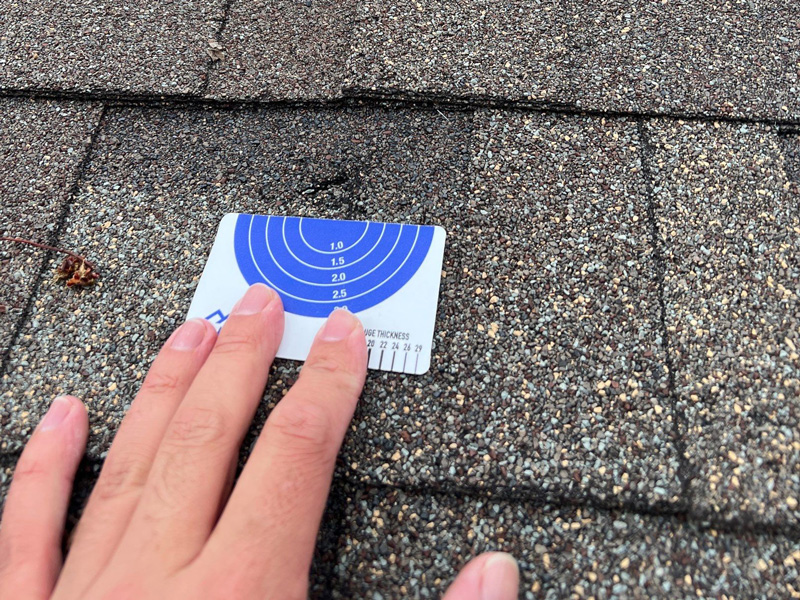What are Signs of Hail Damage on My Roof?
Do you think you might have hail damage?
Your friends at Van Martin Roofing have the experience and expertise to walk you through all the telltale signs for hail damage on your roof at home.
When hail hits us here in the Miami Valley Ohio area, it can damage your roof, your home and other types of personal property.
Here in the Greater Dayton, Ohio area, our homes are occasionally subjected to the harsh whims of Mother Nature, with hailstorms being one of the most formidable and costly.
Hail can inflict significant damage on our roofs, potentially leading to expensive roof repairs and even roof replacements if not promptly addressed. Understanding how to identify signs of hail damage is essential for every homeowner. This blog post will guide you to help you recognize hail damage, factors influencing the extent of damage, common misconceptions about hail damage, and preventive measures to protect your roof. If you’ve been the victim of Ohio’s hail storms and need to file an insurance claim or insurance claim with your homeowners insurance, we are the company to call. We can walk around your property with you and give you a free roof inspection to help you file a claim. When it comes to all your storm damage needs, home improvement needs, and roofing needs – Van Martin has you covered. Below are the signs you need to be aware of!
Look For Hail Roof Damage
Finding and identifying hail damage on your roof can be a bit tricky. Nevertheless, there are several distinct signs that can indicate a recent hailstorm has compromised your roof’s integrity. These signs include things like the following list:
- Broken Window or Damaged Window Screens: These are the areas that hail can cause the easiest damage, so be sure to check here first.
- Dents on Shingles: Next, look up top. Hailstones often leave noticeable dents and impressions on your roofing shingles. You might not be able to spot them from the ground, hence why calling a professional is recommended.
- Cracked Shingles: In addition to dents, look for cracks. The impact of hail can cause roofing shingles to crack, leading to potential roof leaks. This can be costly if not caught.
- Granule Loss: Additionally, you also want to keep an eye out for excessive granule loss in your downspouts and gutters. Over time, this issue can expose the roof’s underlayment to further damage.
- Damage To Flashing: Finally, check for small dents on flashing and vents. This includes gutters and downspouts. These areas are especially vulnerable to hail, which we can usually spot quickly.
In any case, if you suspect you have hail damage, it is essential that you schedule an inspection with our professional roofing contractor who can assess the extent and recommend the necessary actions you need to take. We specialize in storm damage. We will look at the factors that determine your roofs level of hail damage.
Factors that Determine Your Roof’s Level of Hail Damage
Several factors can affect the severity of damage your roof sustains from a hailstorm include the following:
- Wind Speed and Direction: Wind can change the angle of hail’s impact, affecting where damage occurs most.
- Roofing Material and Age: This always plays a role. The different types of materials and the older roofs are more susceptible to damage.
- The Hailstone Size and Density: Larger and denser hailstones inflict more damage. In any case, to truly determine the extent of damage, you need to schedule an inspection.
For a more in-depth understanding, consider giving us a call! We are always standing by with local storm damage experts and hail damage experts throughout the Miami Valley Ohio area.
Roof Damage Hail Does Not Cause
In addition to hail damage, it is also important to recognize what hail damage doesn’t look like. The following is our list of things homeowners commonly mistaken for hail impact:
- Manufacturing Defects: Some shingles are made with imperfections. This happens during production. Poor production is not hail damage, but it can be a recipe for further disaster in a hailstorm, if not properly assessed and repaired beforehand.
- Blistering on Shingles: This is something caused by moisture inside the shingle, not by hail itself.
- Foot Traffic Damage: This is a huge no-no if you’re walking on your roof. It results from people walking on the roof and is characterized by localized wear rather than hail’s random pattern. With more than 20 years of experience, we easily spot the difference.
In any case, knowing and understanding these differences is essential for accurately assessing hail damage on your roof. You can delve more into the difference between hail damage and blistering by visiting another one of our blog entries on this subject matter!
 Protect Your Roof from Hail By Doing These Things
Protect Your Roof from Hail By Doing These Things
Although it is impossible to make your roof 100% hail-proof, there are several measures you can take to minimize potential damage. They include the following:
- Regular Inspections from a Professional: We identify and repair minor damage before a storm can make it worse.
- High Quality Materials: We recommend using impact-resistant shingles specially designed to withstand hail.
- Cut & Trim Overhanging Branches: You can also reduce the risk of branches falling on your roof during a storm by trimming tree limbs.
For more advice on dealing with the aftermath of a storm, give us a call anytime. You can also learn more about how to deal with storm damage by reading this earlier blog post!
Still Need Help? Give us a call!
Promptly recognizing signs of hail damage is essential. This can save you from facing extensive repair work down the road. We urge our amazing customers to stay vigilant and when in doubt, don’t hesitate to give us a call or contact us at Van Martin Roofing. Our team of professionals is always ready to assess and address any concerns you might have regarding hail damage or any other roofing issues. We are here to ensure your home remains protected against the elements at all times.



